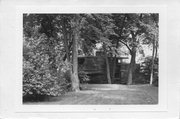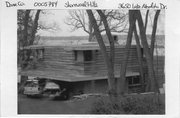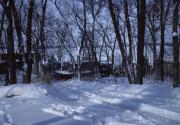| Additional Information: | A 'site file' exists for this property. It contains additional information such as correspondence, newspaper clippings, or historical information. It is a public record and may be viewed in person at the Wisconsin Historical Society, Division of Historic Preservation-Public History. Pew still owned the house as of 1979. Apprentices did much of the construction work for this house.
Perched amongst trees on a hillside above Lake Mendota, the Pew House is one of Wright's finest Usonian designs. The Usonian house, Wright’s Depression-era answer to the need for low-cost housing, achieved economy by using prefabricated components, inexpensive wooden walls, efficient plans, and under-floor heating. The house of research chemist John Pew and his wife Ruth embodies Wright’s ideals, with its cypress-wood and limestone surfaces blending naturally into the surrounding environment. The house’s massing responds to the sloping terrain. The hillside anchors the house at one end, but then it drops sharply away, leaving the building suspended above a ravine. Except for a supportive limestone pier, it seems to float in air.
The house is organized in three parts, stepping down toward the lake. From Lake Mendota Drive, the topmost layer reveals only a square box containing bedrooms, with rectangular window canopies and a yawning carport wrapping around its corners. Behind the box, the house expands into a wide, open balcony, and below that, the largest and lowest layer contains the rest of the living space. Wright often opened the rear of a house to the landscape; here, the Pews’ living room leads to a cantilevered balcony overlooking the water. The diagonal placement of the rectangular house exposes two sides to the expansive lake view. Throughout the design, ribbon windows, projecting terraces, and lapped bands of cypress siding lend a typically Wrightian sense of horizontality.
The Pew House has been called “a poor man's Fallingwater,” after the famous Edgar J. Kaufmann House, with its cantilevered and stepped massing, that Wright designed in Bear Run, Pennsylvania. In response, Wright reportedly called Fallingwater a "rich man's Pew House." He drew on the Pew design to create similar Usonian houses in Arizona, Illinois, and Michigan. |
|---|
| Bibliographic References: | Perrin 1967, p. 156.
Wisconsin State Journal, p. 3I, 2/19/1995.
Heggland, Tim. "Shorewood Hills Intensive Survey Report." 2000. SHSW: Historic Preservation Division. p 83
Wright and Like Madison Walking Tour brochure, 2015.
Buildings of Wisconsin manuscript.
Perrin, Richard W. E., Historic Wisconsin Architecture, First Revised Edition (Milwaukee, 1976). |
|---|





